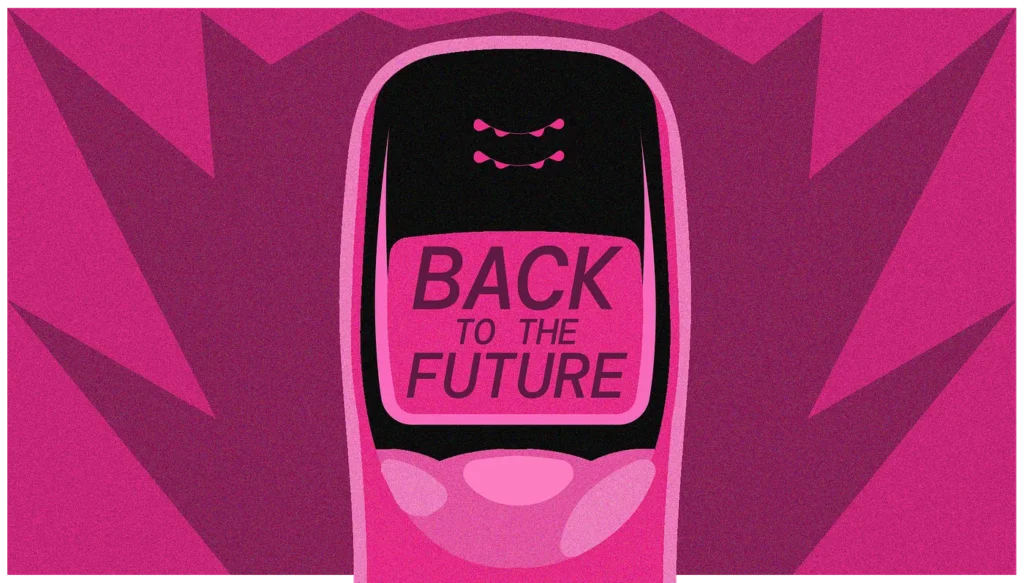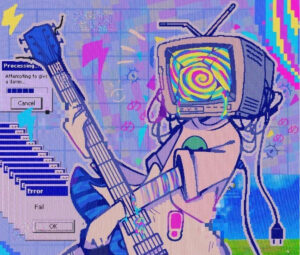
the return of the past in a hyper-modern world
The irony of our digital era is that the faster it moves forward, the more people look back. Every innovation — from AI assistants to foldable smartphones — seems to trigger a collective sigh for what we’ve lost: tangibility, patience, imperfection. This longing has a name that perfectly fits its cinematic echo — the Marty McFly Effect, a cultural reflex where society turns its eyes to the simpler machines of yesterday in search of comfort, authenticity, and control.
The evidence is everywhere. Vinyl records outsell CDs. Analog cameras are prized by a generation raised on megapixels. The Nokia 3210 — once a basic handset — now enjoys cult status as a minimalist object of rebellion against constant connectivity. The more technology surrounds us, the more we crave what came before.
dial-up desires: the appeal of old devices
The early 2000s feel oddly appealing in 2025. Maybe it’s the nostalgia of the first ringtone, the click of the T9 keypad, or the pixelated charm of “Snake.” Those objects carried a quiet rhythm — a tempo we could manage. The Nokia 3210didn’t ping endlessly; it waited patiently. Its limitations were gifts: conversations happened face-to-face, photos were framed with intent, boredom existed.
In contrast, today’s devices demand attention. Notifications blink, algorithms scroll infinitely, and the very concept of “off” has vanished. The longing for the past, therefore, isn’t a rejection of technology itself — it’s a rejection of perpetual presence, the feeling that we can never escape our screens. The Nokia becomes a totem of resistance, a reminder that simplicity was once enough.
the analog revival: vinyl, film, and the tactile renaissance
Walk into any urban neighborhood and you’ll find vinyl shops thriving beside digital streaming ads. A resurgence of film photography runs parallel to the explosion of smartphone cameras. The grain, the wait, the imperfection — all the things technology once promised to eliminate — have become aesthetic ideals.
Vinyl records, with their pops and hisses, remind listeners that sound can have texture. Analog cameras like the Contax T2 or Canon AE-1 resurrect a sense of ritual: you wind the film, you measure light, you accept uncertainty. The process itself becomes art.
These revivals aren’t just nostalgia — they’re forms of cultural repair. They restore what the digital world eroded: slowness, patience, and physical connection. In the same way a handwritten note feels more human than an email, the crackle of vinyl or the delayed gratification of film photography reconnects us with time as experience, not efficiency.
the philosophy of boredom
“Back to the future,” the image says — not as an act of regression, but reclamation. In the past, boredom was fertile ground. It birthed creativity, daydreaming, self-reflection. Today, we’ve optimized away boredom with endless scrolls, short videos, and algorithmic entertainment. Yet research increasingly shows that boredom is essential to mental balance.
When you waited for a CD to load or a Polaroid to develop, you had no choice but to pause. That pause — uncomfortable yet transformative — was where imagination lived. To be “bored like a limpet,” as the metaphor goes, is to be still, attached, waiting. In that stillness lies meaning.
The modern mind, conditioned to stimulation, now seeks boredom like a lost nutrient. Hence the rise of digital detox retreats, minimalist phones, and unplugged weekends. We are learning to miss silence because it has become a luxury.
why we miss imperfection
Perfection, once a goal of technology, now feels oppressive. Everything is too sharp, too smooth, too immediate. Old devices remind us that glitches, cracks, and loading times were signs of life. There’s something profoundly human about the analog error — a skipped note on vinyl, a blurred photo, a frozen screen that demanded patience rather than panic.
In design circles, this aesthetic has become a movement. Brands emulate retro interfaces; app developers mimic the chunky typography of early web browsers. Even fashion echoes the Y2K period with reflective surfaces and pixel art references. Imperfection has become authenticity’s last defense.
generational nostalgia: the retro-millennial loop
The Marty McFly Effect isn’t limited to those who actually lived through the dial-up age. Gen Z and Alpha, born into seamless digital ecosystems, are among the most active participants in the retro revival. For them, analog culture represents mystery and depth — a world without the algorithmic gaze.
Owning a flip phone or a film camera becomes a symbolic act of rebellion. It says: I choose presence over performance.Social media trends like “#RetroReset” and “#OfflineAesthetic” amplify this counter-movement. It’s less about fetishizing the past and more about reclaiming agency in a world that monetizes attention.
the materiality of memory
Objects carry memory in their weight, texture, and sound. The plastic shell of an old cassette tape, the resistance of a rotary dial, the glow of a CRT monitor — these sensations form emotional anchors. In contrast, today’s cloud-based storage feels intangible, disposable, fleeting.
To hold a photo instead of scrolling past it is to inhabit memory rather than consume it. Analog artifacts invite us to engage physically — to rewind, to flip, to touch. The return to these objects is not simply nostalgia; it’s an act of material remembrance, a way of making the intangible real again.
culture
Cultural historians argue that nostalgia operates in twenty-year cycles. The 1980s fascination of the 2000s has now given way to early-millennial revivalism. But beneath the surface, this isn’t just repetition — it’s rhythm. Technology evolves faster than culture can adapt, creating emotional lag. The Marty McFly Effect is that lag materialized: a collective yearning for the emotional vocabulary of older tools.
Each technological leap leaves behind an emotional residue — the tactile pleasure of buttons, the ritual of waiting, the intimacy of shared spaces. As AI, automation, and virtuality accelerate, we instinctively cling to what feels human.
minimalism as counter-culture
The return to retro devices aligns with a broader minimalist philosophy. Owning fewer, simpler tools becomes a moral stance against digital excess. The Light Phone, a device designed solely for calls and texts, sells not as an innovation but as a de-innovation — a way to subtract rather than add.
This counter-movement echoes slow fashion, organic food, and sustainable design: all reactions to industrial and informational saturation. We no longer chase speed; we crave stillness. The analog lifestyle becomes a protest against digital acceleration — a soft revolution of restraint.
the irony of retro innovation
Tech companies are not blind to this longing. They monetize nostalgia through design — from reissued flip phones to apps that simulate VHS filters. Apple’s skeuomorphic era, once mocked, now resurfaces in subtle gradients and rounded corners. Retro becomes the new luxury.
Even digital culture participates in this paradox. Social platforms like TikTok popularize “analog cores”: lo-fi edits, VHS aesthetics, Y2K typography. The past is constantly remixed to soothe a hyper-present audience. The result is a loop of aesthetic comfort, where nostalgia becomes both refuge and product.
impression
We are not the first generation to feel overwhelmed by change. The Industrial Revolution provoked similar anxieties; the radio once threatened conversation, television endangered imagination. Yet every era finds its balance by revisiting its roots.
Our current wave of nostalgia isn’t regression — it’s recalibration. It’s the world pausing to breathe. The Nokia 3210, the vinyl player, the film roll — they symbolize the courage to slow down, to choose less, to remember that silence can be sacred.
In a time when algorithms dictate our choices and devices predict our desires, longing for the past is a declaration of selfhood. We may never return to boredom entirely, but we can reclaim fragments of it — the stillness, the patience, the imperfection that once defined being human.
No comments yet.







